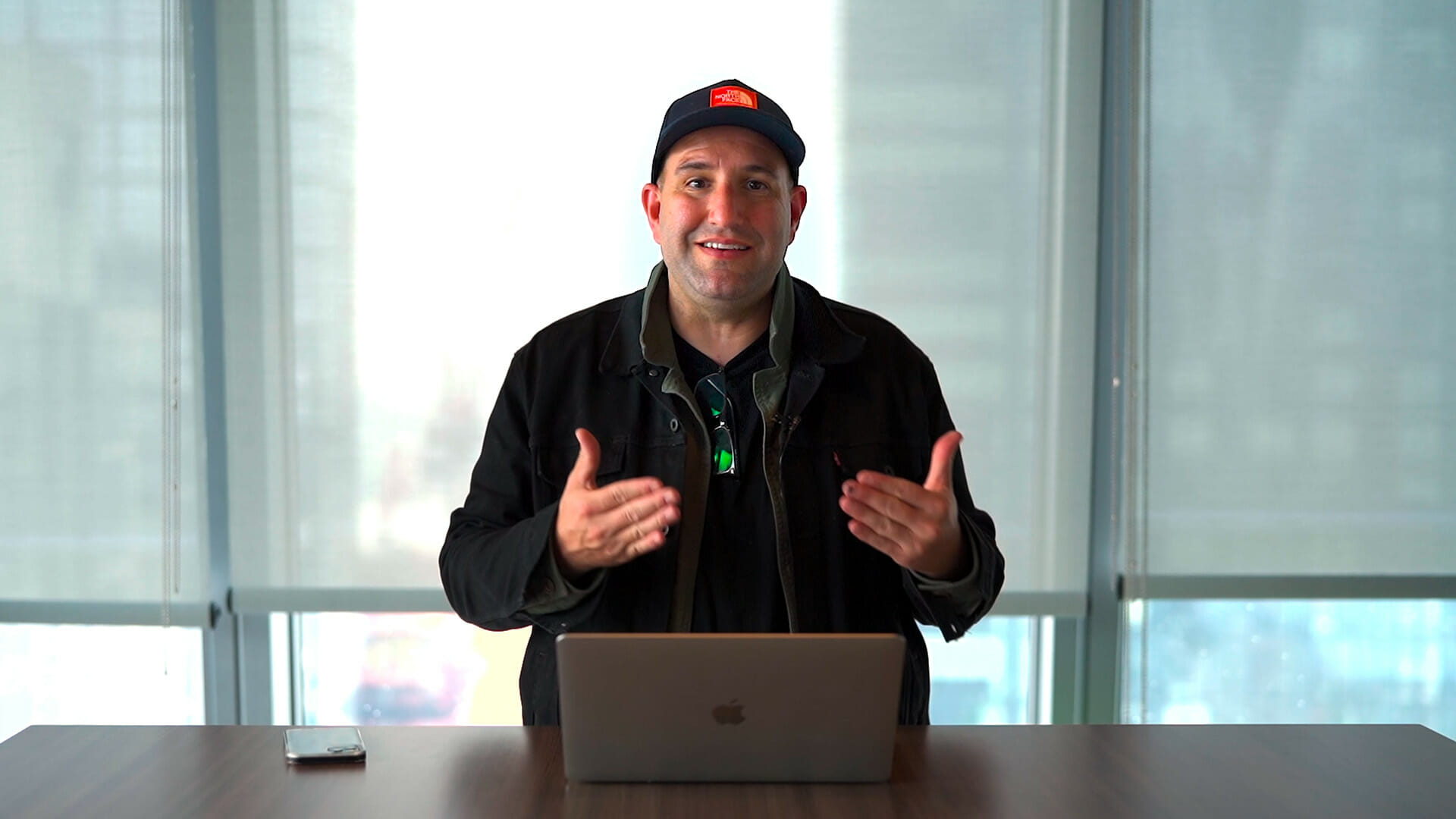We answered your questions.
You asked, we answered! Our Building While Flying Q&A is back with Joe Quattrone, SVP, Head of Education. In this episode, he answers more questions submitted by our listeners across our social channels.
”The more you believe your business will succeed, the more it actually will start to succeed.
Joe QuattroneSVP, Head of Education, The Sasha Group
Transcription
Katie Hankinson (00:00):
Welcome to building while flying a Sasha group podcast, where we interview business leaders about how they tackle challenges, stay resilient and navigate ever-changing skies.
Joe Quattrone (00:11):
Hello, all. Thanks for listening to the building while flying podcast Q and A edition I’m Joe Quattrone, and I’m gonna be your host for today, and we’re gonna read some questions that we’ve scoured from the internet, all of our legions of fans out there. The first question comes from Kevin Bohm, who asks I created a new consumer product. What would be your thoughts on the first step in bringing that product to market in a DTC functionality? Um, so there’s a lot of different ways you can go with this one, Kevin, um, you know, really depends on what your product is, what your price point is and how easily accessible it is to customers, how easy it is to buy how easy it is to ship. Uh, but I’d say the first step is probably understanding market viability and whether or not you have a market.
Joe Quattrone (00:57):
So, uh, creating some sort, sort of a testing forum, whether it be Amazon, um, or, you know, starting off with your website and building in the e-commerce functionality to it. Um, you have to see whether or not there’s some demand there for the product, um, somewhat naturally. Um, obviously it’s gonna be hard to do that for a new to world product or a new, new to the world consumer category that hasn’t existed yet. So there are gonna be some needs for, um, small levels of advertising spend, whether it be on Amazon or Google search, something like that, Facebook ads, um, what have you, but testing the viability of the product and market and understanding what people are willing to pay for the product is probably the first step. And it’s not an easy one. It’s gonna play out and unfold over, uh, several months. And honestly, you’re gonna come up with a lot of different iterations of what works best for you and your product.
Joe Quattrone (01:48):
Um, and yeah, that’s really kind of the direction I’d had if I were you. And the next question comes from Daniel Wagner and he asks as a chef apparel brand that has success locally. How do I scale globally and preach culture before sales? Um, I’ve, I’ve dealt with some, uh, business owners and entrepreneurs who are dealing with this exact same issue. And the interesting thing is that the issue never usually has anything to do with the market viability of the product. It usually has to do with internal employee buy-in and retention, um, because the company’s either pre-revenue or they’re doing very low amounts of revenues and their early offerings. And they’re trying to be inspired by why to stick around on this brand when I could be making more money to go elsewhere that may or may not be the, the situation that you’re in. But if you are in that situation and you’re trying to figure out how to set the tone for your company, set the culture so that people are really getting, you know, bought in on the brand.
Joe Quattrone (02:46):
Uh, what I would suggest is you going pot committed as much as you can, and you’re probably already there, but even more, if you think you’re pot committed, add in some more to the pot, um, start leveling out most of the expectations for the success of this brand on yourself versus putting too much expectation on your people to be perfect. Uh, chances are, they’re not in your head. They don’t understand what makes your chef apparel brand so awesome and inspiring. They need you to go out into the market and show them and inspire the masses. Um, I can guarantee you this coming from a guy that works at a company that was built and, and grown and scaled by Gary Vaynerchuk, it’s definitely very easy to stick around a place like VaynerX when you’re constantly surrounded by the right type of messaging and the right type of culture and tone.
Joe Quattrone (03:33):
And that’s where you need to get. I think it’s just a matter of time, but just keep hammering that away, uh, and keep holding yourself to the highest possible standard out there. And the next question comes from Trevor Matthew Marks. What do you think it’s gonna take for brands and companies to create their own projects, join other collaborations and get involved with the NFT space. If you had to guess, when will it be mainstream, just like brands and companies having a Facebook and Instagram or Twitter is mainstream today? Uh, well, that’s a great question, Trevor and I was there at the early days of brands jumping on social media back in like the Barack Obama term one years. Um, in terms of mainstream in society today, I still think we’re probably about five to 10 years off of when every brand out there has an NFT project, whether or not it’s a collaboration or they’re doing their own drops.
Joe Quattrone (04:22):
Um, but I’d say a couple of building blocks to get brands from, you know, today to that, that space is really thinking about their brands in the context of how users look at NFTs, right. Are you getting involved from the perspective of you want this to be a brand publicity play, right? Are you gonna work with famous artists or are you gonna do drops that have collectability to them? Is it purely about the, the brand expression or do you want to have some sort of utility involved, right? Are you gonna be looping in loyal customers and building a rewards ecosystem and having an NFT that’s more based on the underwriting smart contract. Uh, and if you don’t understand what either of those two things mean, then I think the first step for a brand, as you need to go to town on your homework and realize just all of the potential that NFTs and the web 3.0 Space have to offer you as a brand, right.
Joe Quattrone (05:16):
I would spend months, um, you know, laboring over all of the finer point details, cuz there really is a lot of stuff you can do in the web 3.0 Ecosystem specifically in the NFT universe. Um, but I wouldn’t want to rush to judgment and get involved now just because it feels like everybody else is getting involved, you’re gonna get that sense for the next five years where it seems like every day there’s a new brand getting into an NFT project. And that’s because there will be a new brand getting involved in NF project every day. But that doesn’t mean that it’ll be mainstream, right? Just like it was back in 2008 where every day it seemed like a new brand was getting on Twitter. It still didn’t mean that Twitter was mainstream from brands in 2008. The next question we have comes from Carey J Chop.
Joe Quattrone (05:57):
What’s better than word of mouth and referrals for an entrepreneurs. And do you have some best advertising practices or is there one? Um, that’s a great one. Um, I’d say the answer is pretty simple. There is nothing better than word of mouth and referrals. The only main difference is the amount of scale that you can compete with as a small business and entrepreneur due to what the internet and social media has to provide. Right? So if you were an, if you were an entrepreneur back in the eighties, chances were, you were not an internet entrepreneur. You might have had a small business that was operating down on main street. Maybe you had a restaurant, maybe you had a car dealership or something like that, but there wasn’t the kind of referral ecosystem that now exists today. Um, especially if you’re in the world of direct to consumer and you don’t really have to have a physical brick and mortar or retail space, you could be, you know, Susie and Maine could be referring Bob in Denver.
Joe Quattrone (06:47):
Uh, that could be part of your referral ecosystem. Uh, and that’s, I wouldn’t say I’d probably stop short of saying infinitely scalable, but it’s way more scalable than it was once upon a time was, uh, so I’d say yes, the answer is no. And that sounds weird. Yes, the answer’s no, but no, <laugh>, there’s nothing better than referrals. Uh, the biggest, uh, you know, differences in the, the thing that you have to understand about it is I’d say if you were gonna build a best practice around it, it’s content, right? So getting good at making content, putting it on an app like a TikTok or an Instagram being seen and being more visible, making sales that way so that you can, you can actually recruit new customers from far and wide. Uh, that’s really the best practice is getting new customers in and then having them refer you to other people.
Joe Quattrone (07:32):
Uh, so that customer experience is a sleeper as well. Don’t forget about post purchase and really how to cultivate that full life cycle. All right. So the next one comes from Althea’s Tropical Delights and their question is my main business is in the tropical rum cake space. Now I’m AB I’m about, I’m about to enter the market with my savory tropical meals. And my question is, how do I make sure when I promote one, I don’t drown out the other ones, uh, giving each one of them their own special wealth. Uh, I’d say that you could go a lot of different ways with this answer. And one of them could be, it doesn’t matter. You could actually drown out the other cakes and you know, maybe you just have a hero item on your menu that wouldn’t, you wouldn’t be the first person that went to market with a hero SKU, um, you know, within their ecosystem.
Joe Quattrone (08:19):
But if you really, if, if, if your energy is really around creating that equity across the lineup, which sounds kind of weird that I’m using the word equity, but if you wanted to be equitable across the lineup of rum cakes, you have, you gotta understand the difference between organic and paid social media, right? So from an organic perspective, the stuff you’re doing every day, the stuff you’re making content for and putting out there, don’t worry about how equitable you are, right. Just make sure that everybody gets some posting here and there, uh, that every rum cake gets a post here and there. Uh, but you really can’t control how people consume it and how great your content is being assembled. Um, but just know that if you, if the way you put together your savory rum cake, for some reason, you put more energy into that where the video comes across better, it might go viral, but that virality will have spillover effect that will equal out to more visibility and reach for your other rum cakes that you’ve done videos for as well.
Joe Quattrone (09:12):
Um, but if you want to control the scenario, you probably want to consider paid media, right? And across a variety of different platforms like Facebook, Instagram, TikTok, uh, Pinterest, even, uh, and they all have different ways. You can target people, whether it’s, you know, based on geo geography or socioeconomics or interest based, um, that is one surefire way. You could take a pot of money and spread it out equally across all of your different SKUs and actually put those rum cakes into market. So they are all getting somewhat equal distribution. Um, and I would say that having a good organic versus paid, um, understanding is gonna be table stakes for you as a business. Anyway, the next one comes from Travis Andrew Cameron, what are three tips for traveling light on the entrepreneurship journey and how do I keep the ability to move fast? So number one is gonna be putting a lot of the responsibility and accountability on yourself.
Joe Quattrone (10:09):
Number two is having open mind and being optimistic. The more you believe your business will succeed, the more it actually will start to succeed. And then number three, I, I think being very positive and, and kind towards the people that you’re bringing along up in this system is also very, uh, very interesting and unique. Uh, I think a lot of different businesses out there are playing, uh, placating to fear. Uh, they’re driving their business, uh, on the standards of results. And of course we all know that results are what will keep you in business, but it’s very hard to get results when you’re not, you know, treating your employees or your customers with the utmost respect in dignity. Um, and just know that like, no matter what happens like you are who you are and you can control what you can control, and that includes your attitude and your optimism. So I think the more you more energy you put into being that kind of a leader and that kind of a salesperson entrepreneur, the more, not only your employees, but your customers will re react and resonate with you as well. So thanks for asking all of your questions. It does truly gimme a lot of joy when I get to answer some of these when I’m here in Hudson yards visiting. Um, so keep listening to the building wall flying podcast.
Katie Hankinson (11:23):
Thanks for joining us for building while flying today. I hope you learned as much as we did. We’ll meet you right back here next time for another flight.
Mickey Cloud (11:34):
If you’d like to hear more about how business owners and brands are navigating these times tune into the next episode. And if you’re so kind, please rate and review us, plus we’d love feedback. So let us know what you think, what you’d like us to dig into next on building while flying across brands, businesses, marketing, and more
Katie Hankinson (11:49):
Original music by Fulton street music group.
Welcome to Building While Flying!
This weekly podcast is brought to you by Sasha Group. We’re the consultancy meets agency arm of the VaynerX family of companies. We help ambitious companies build strong brands that flex with the times through strategy, branding media and marketing.
In ever-changing times, businesses and brands have to shift and adapt. And across all sectors, there is an air of experimentation. Business owners are trying new things out in the wild; building the plane while flying.
Our pilots, Katie Hankinson and Mickey Cloud, will be talking to a diverse range of business leaders and founders. They’ll explore how these guests tackle various challenges while staying resilient and committed to growth. Through these real-life examples of strategies put into practice, we hope to inspire you to experiment and develop your own strategies as we all navigate these uncertain times together.
Scaling a brand, DTC, and more.
You asked, we answered! Our Building While Flying Q&A is back with Joe Quattrone, SVP, Head of Education. In this episode, he answers more questions submitted by our listeners across our social channels.
Other in-flight topics:
- Direct to consumer (DTC) marketing
- Scaling a personal brand globally
- Making NFTs mainstream
- Advertising best practices
- Moving fast as an entrepreneur
Links | Connect with Joe and The Sasha Group
- Joe Quattrone LinkedIn: https://www.linkedin.com/in/superquattrone/
- Joe Quattrone Twitter: https://twitter.com/Superquattrone
- The Sasha Group Instagram: https://www.instagram.com/thesashagroup/
- The Sasha Group Twitter: https://twitter.com/TheSashaGroup
- The Sasha Group LinkedIn: https://www.linkedin.com/company/thesashagroup


